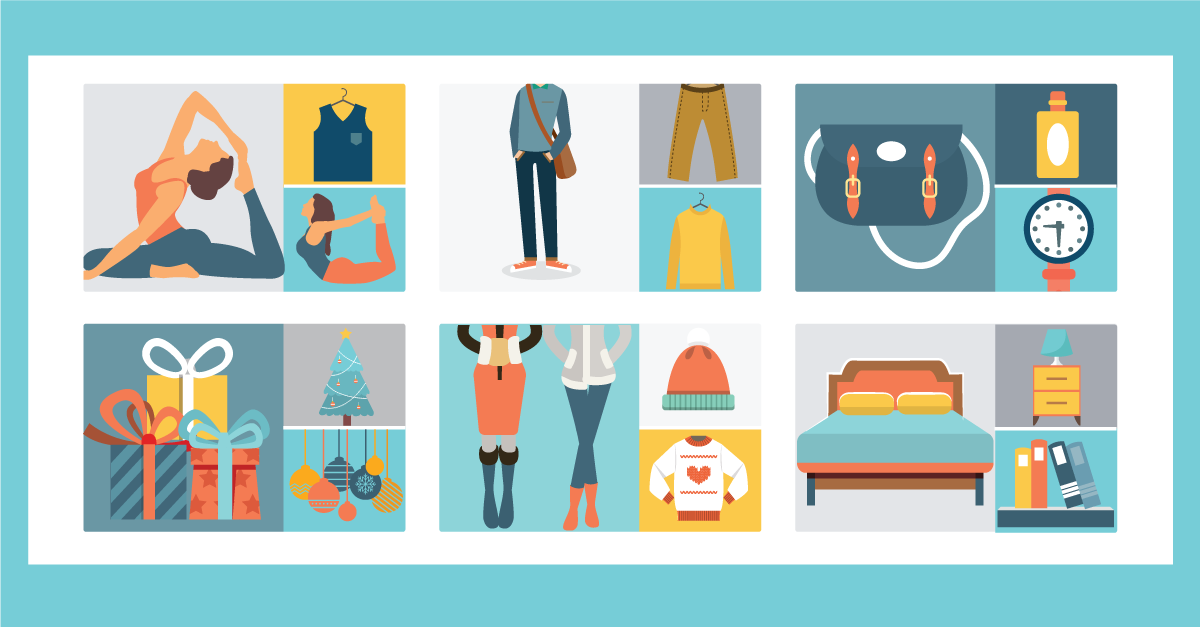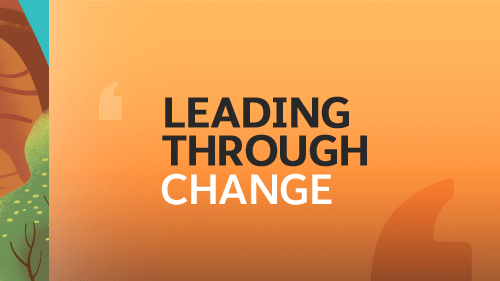At Mozcon 2016, the annual SEO, social media, and online marketing conference, Rand Fishkin of Moz shared that Pinterest receives the sixth most traffic from search engines on the web. Since 44 per cent of online shoppers begin their online search for products on search engines, that’s huge. Only one of the top six sites receiving traffic—Amazon—is actually an ecommerce site, and it ranks number four. Shocker, right? And Facebook only makes it to number three.
Pinterest gets a lot of search traffic. What makes it more impressive is that Pinterest is a pretty unique social network. It combines both visual and text information, the two basics of any brand’s digital image. Bryan Galipeau, Nordstrom’s social media manager, calls Pinterest “the world’s biggest wish list.” Alex Mendoza, managing partner with social media research firm Stylophane, calls it “an online scrapbooking tool.” Some marketers refer to Pinterest as a “sercial,” a combination of a search and social site.
Even so, the potential for Pinterest as a marketing tool for retail businesses might not be obvious at first. This article is all about how you can master the colourful arts of the sercial to boost your reach, engagement and, ultimately, your bottom line.
If You Sell Products, You Should Be Pinning
- Every month, people do more than 2 billion searches on Pinterest
- Over 100 million people worldwide have pinned 75 billion pieces of content
- There are 130 million visual searches on Pinterest every month
- The most popular searches:
- Furniture
- Home décor
- Style ideas
- The most popular searches:
- Users are 3 times more likely to see local ideas in search results and related Pins than they were just one year ago
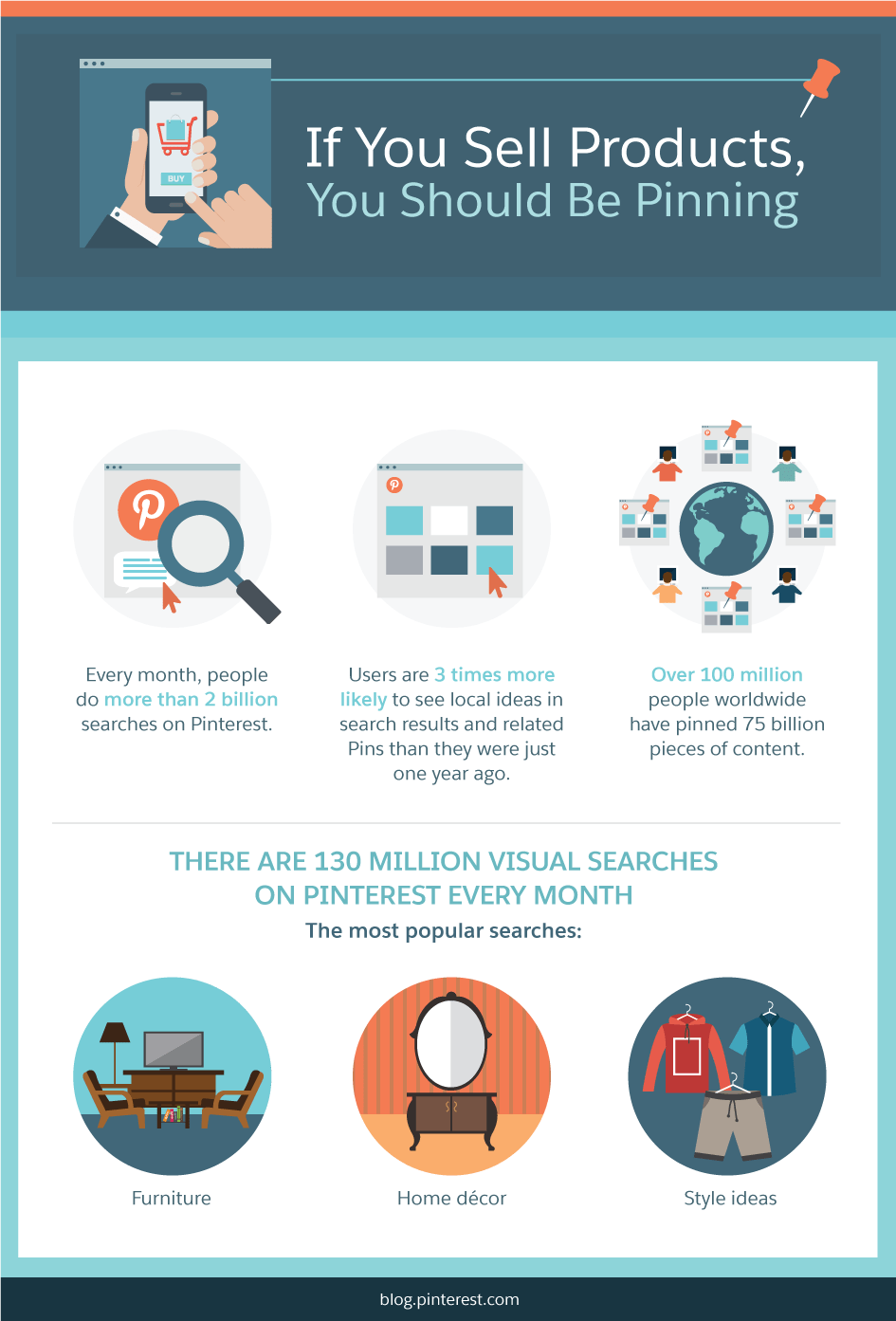
Who Runs the World?
SEO, or search engine optimization, is critical for getting web traffic, and Twitter and Facebook have become indispensable marketing tools for many retailers. These largely text-based systems might look like they run things around here, but Facebook posts with images get way more engagement than those without them, and images are the most clickable content on Twitter.
Did you know that people only read about 20 per cent of the text on your webpage? And that’s not just because people can’t wait to see what your products look like. It’s because images are far more appealing to the human eye. Because 70 per cent of all the body’s sensory receptors are located in the eyes, the human brain processes images 60,000 times faster than text, and a whopping 90 per cent of all information sent to the brain is visual.
So while Facebook and Twitter might lead the pack in sheer numbers of users and perceived usefulness, it’s clear they owe much of that to image-based content—and that’s exactly what Pinterest excels at.
Should your retail business invest in Pinterest? If your audience is largely females between the ages of 18 and 49, perhaps with a penchant for do-it-yourself projects (DIY), the answer is yes. If your audience is mostly men, you should still consider it: The male audience is growing rapidly, and Pinterest is working to appeal to this segment of the population. As an early adopter, your male-facing business could be a trailblazer on Pinterest.
Whether you’re a trailblazer or you’re keeping up with the pack, you need a winning Pinterest strategy.
Pinterest Strategy
Pinterest boasts 150 million monthly users—and counting. What’s even better for you is that this “smaller” social network offers better traffic than other social networks. It sends up to five per cent of traffic to websites. While that’s behind Facebook’s traffic to websites, Pinterest does it with fewer users, and with those who are ready to shop. That means you get higher-quality traffic right out of the gate.
So how do you capture the attention of your Pinterest audience?
Start with High-Quality Images
For a digital storefront, the most important thing you can do is invest in high-quality images. Short of actually trying out your products, people want to see images that are colourful and show detail. Those are excellent selling points for physical products. Mendoza even goes so far as to say “all online revenue from shopping relies on the quality of the images.”
First and foremost, that means images of your products. Shoot high-quality, well-lit photos that can be digitally edited. It’s likely you’ll need to compress them before uploading them to the web so your pages don’t take forever to load, but you’ll get the best results if you start with the highest quality images possible. The same goes for other images you may use, like stock photography, memes, and other graphics.
Organize Them into Strategic Boards
The genius behind Pinterest isn’t that it is image-heavy. Its genius is the way it allows users to capture, organize, share, and discuss those images. Pinterest is known for vacuuming up people’s time for a reason: It’s easy to jump from pin to pin. For retailers, this is only true if you organize your pins and boards in a way that helps lead users in the direction they need to go.
Let’s say your business specializes in selling wedding fashions such as bridal gowns, veils, bridesmaid dresses, tuxes, and the like. How can you organize and name your boards so your ideal customers find you, pin your content, and get lost dreaming about using your products on their big day?
Keep Your Pins Organized
- Keep boards specific so they don’t get overwhelming
- Use subcategories for boards that get too big
- Don’t double pin
- Choose a good cover photo for each board
- Add keywords to the description in your pins—this makes them easier to find
- Rename a board if you find the focus of the board changes
- Arrange your boards in alphabetical order
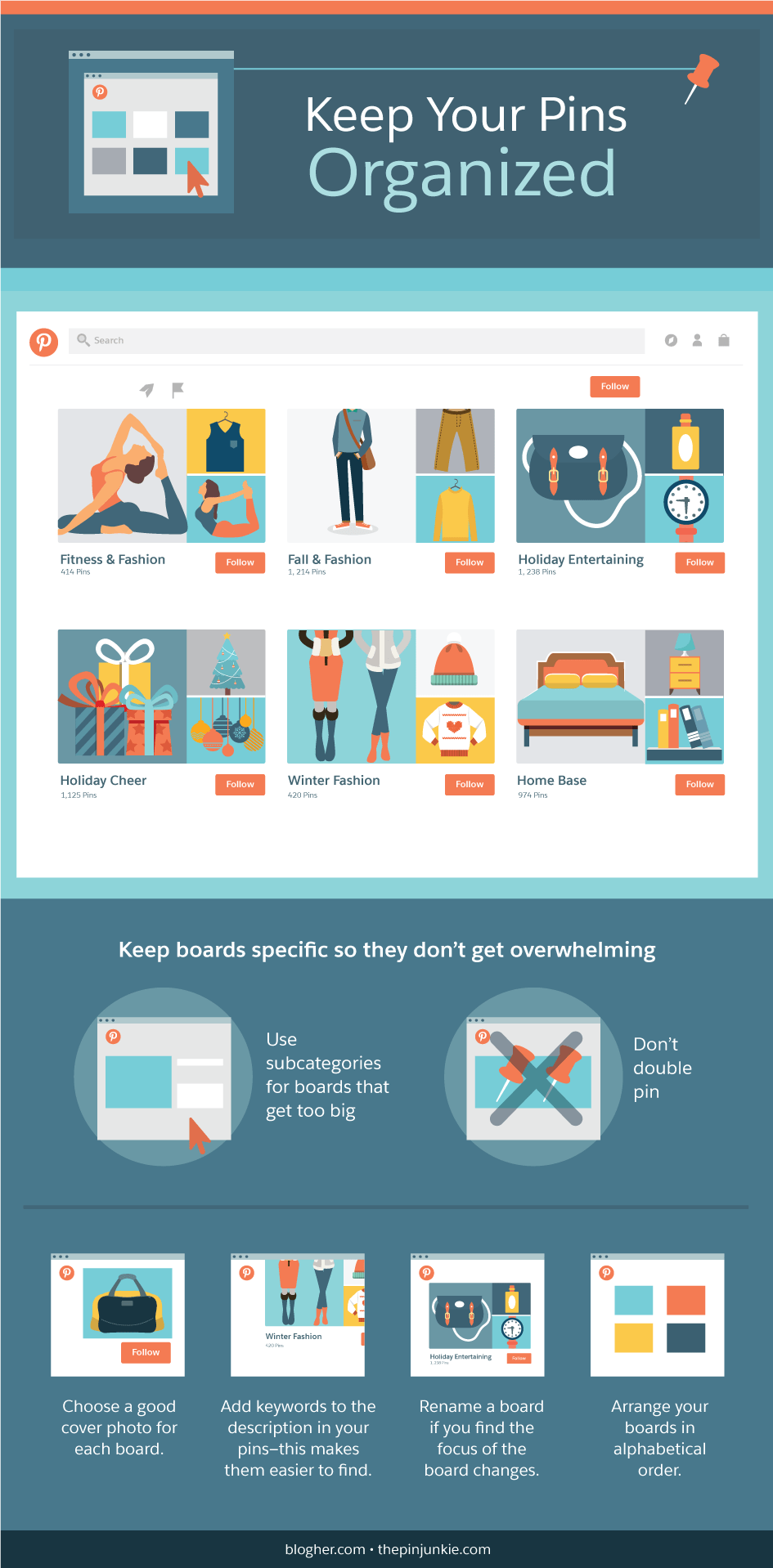
Cataloguing: Group by Product Type
First, find out how your shoppers shop. Chances are, many of them look at one type of item at a time, a lot like looking through a catalog. Today, they’re looking at wedding dresses. Tomorrow, they’ll drum up ideas for bridesmaid dresses. Then they’ll look at tuxes. Creating individual boards for each of these types of products will help customers who are looking for something specific find exactly what they want fast. Pinterest is like a complete, searchable, shareable catalog.
Theme-Based Boards
Of course, not all of your customers know exactly what they want. Some are there just for ideas or to express themselves. For these users, you want to provide more of a complete experience. Using the previous example, you’d group wedding fashions by board with titles like, “Retro Weddings,” “Outdoor Weddings,” or “Pink and Grey Weddings.”
Chronological Boards
Many retail businesses have busy seasons and slow seasons. If you sell electronics, clothing, toys, or home goods, winter holidays may be huge for you. If you sell fitness or outdoor equipment, you gear up for summer. For wedding fashion, spring and summer will be busiest. Build a few boards designed to capture season-specific interest and funnel traffic to your website: Boards based on seasonal products or limited-time sales are an easy way to regularly add new content and continue generating pins.
A Few More Tips
Naming your boards is crucial. You want to tell people exactly what your board is organized around using relevant, searchable keywords as well as intriguing or exciting language—a bit like creating a short headline for a blog post.
Lastly, try not to delete a board or pin unless absolutely necessary. Sure, you want to keep your content fresh by adding new pins, but the old ones can work just as hard for you, even if they feature products you no longer carry or links that no longer exist. Just have a plan for nurturing those leads, like landing pages that suggest other relevant pages or offers of similar, but updated, products.
Update Often
Google likes fresh, new content, and so do Pinterest users. If your business has anything to do with fashion, crafts, DIY, travel, or weddings, the decision to regularly update pins as seasons and trends change may seem obvious. Even if your products don’t change often, keep posting new images. You may have to get creative, but more pins mean more chances that users end up on your boards, more followers for you and your boards, and better-trained potential customers on the lookout for something new from your brand.
What to Pin
Now that you have ideas for organizing your boards, it’s time to start pinning. You have high-quality product images that will make great pins. But no matter how many images you have, you’re only a fifth of the way there because Pinterest is, at its heart, a social network, not a marketing platform. If all you do is plug your merchandise, you may turn your followers off because you’re too salesy. Plus, you’ll miss out on the opportunity to bring in leads from people who didn’t know they wanted your products, but found them naturally via other things that inspired them. Kate Spade, a leading brand of women’s wear, uses a mixture of 20 per cent self-promoting pins and 80 per cent purely inspirational content.
So what qualifies as purely inspirational? Quotes qualify. So does pinning other people’s pins. You can also pin images from your other content, such as blog posts, articles, and videos. In our wedding fashion example, pinning the article on ways to make your pet part of a wedding qualifies. So would video on how to create DIY wedding invitations; an infographic on what to look for when hiring a wedding planner could also draw the right audience.
What Companies Should Pin on Pinterest
- Others’ content
- Original content
- What’s popular
- Products—including their prices
- DIY and how-to content
- Before and after images
- Videos
- Gifs
- Images with text overlay
- Infographics
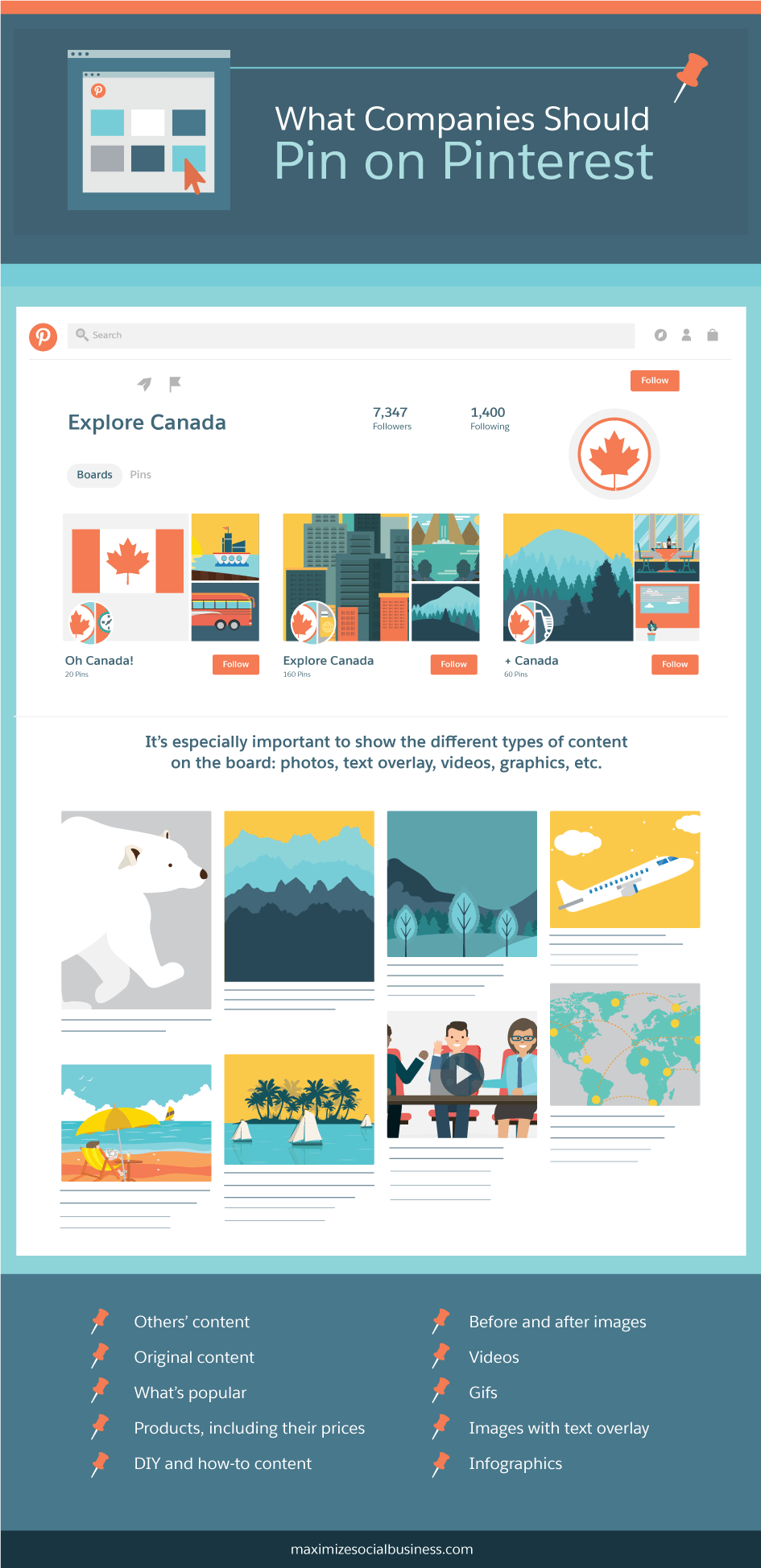
Are You Eligible to Create Buyable Pins?
Buyable pins are a great way to turn product pins into conversions in a streamlined process. Instead of clicking on a product pin and landing on your website’s product page, shoppers can click a “buy now” button and snatch up your merchandise without leaving Pinterest. Buyable pins don’t work for everyone, however, and at the time of the posting of this article, are only available for ecommerce sites using a short list of platforms.
Reaching Out
Just because your pins exist doesn’t mean people will start using them. Here’s how to grow your reach on Pinterest:
- Pin from other boards. Follow people and boards that are relevant to your audience or from people who are your audience. They’ll notice and may head over to your boards as well. Focus your efforts on “pinfluencers,” or trend-setters in your industry who have a lot of followers.
- Promote your pins, especially your promotional pins. Pinterest has tools that allow you to target certain users by interest, location, language, and more to bring your pins to the attention of likely customers who aren’t following you yet.
- Empower users to pin your content by inserting “pin this” buttons on your product pages, blog posts, and anywhere else you think one may be used.
A/B Testing
Like any other kind of marketing, there’s no sure-fire way to guarantee a return on investment. This is where growth hackers have it right. To find out what works best for your audience, you have to test. A/B testing works because it pits two similar pins against each other to find out how even the smallest change affects the number of views, repins, comments, and likes. You’ll learn strategies that will help you hone future pins.
From A/B testing on Pinterest to sharing the right image on Twitter, marketing automation makes your efforts more efficient. See a demo of Salesforce Marketing Cloud by following the link below.
Share "The Best Ways Retailers Can Use Pinterest to Engage Their Customers" On Your Site

